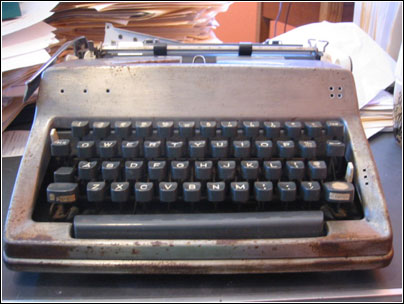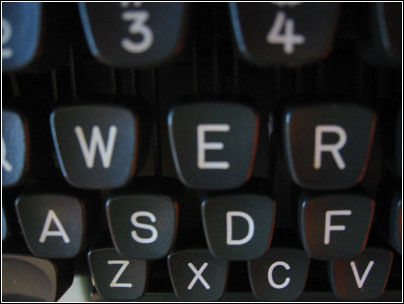If you’re male, you probably acquired, when you reached the brink of adolescence, a machine that burned gasoline or shot bullets, and with it you risked your own life and endangered the lives of others. It took you far from home and gave you an early taste of adulthood’s dark cracks. When I was 14, I acquired a typewriter. An aunt of mine, a high school teacher, had rescued it from her school’s defunct typing classroom in Michigan, and in doing so she rescued me, too. With a manual Olympia typewriter as my companion for the next 10 years, I endangered myself and others and let it take me far from home so it could give me an early taste of adulthood’s dark cracks.

Its metal cover used to be covered in white enamel; in a fit of procrastinating boredom I scratched it off one year, along with the Olympia emblems and the variety of stickers it had accumulated: my AP test numbers, a Hare Krishna smiley face from the San Juan airport, some pieces of radio station bumper stickers, labels from parmesan cheese packages, bananas, and sweet potatoes. (For some reason I never scraped off the sticker on the shift key on the right that says “el tiempo” or the one on the left that says “el espacio.” I said I typed; I didn’t say I wasn’t pretentious about it.)

These are the keys on which I pounded out hundreds of thousands of words in letters and love letters and journal entries and papers for school:

And this is the typeface that I came to think of as the default font for the essence of my eternal soul:

Under the cover are two spools that, at one point, successfully reeled a strip of ink-soaked fabric back and forth between them. The automatic back-and-forth mechanism lost a spring, however, when I was poking around in it during college, so every five pages I had to pop the hood and manually re-reel the ribbon from the left spool to the right or the right to the left, which I mention not only because it’s technically quaint (and it is—you actually had to get ink on your hands) but because it was a humbling change from the momentum of typing, as if I were changing the sparkplugs on my hotrod every three miles.
Over the years such dents and injuries accumulated. Now it’s coated in rust, with stuck keys. I haven’t used it in 10 years because it grinds when it’s not jammed, but I keep it around because it reminds me of when I began to write seriously at about 16. When my aunt gave it to me, I knew how to type (my parents had sent me to typing class during the summer after sixth grade because my mother was tired of typing things for me on a Smith-Corona she’d bought in Hawaii). I was already writing for local newspapers as a kid correspondent, and I figured that if I kept practicing for walk-ons I might make the short fiction team someday.
But with the typewriter my seriousness arrived. “Serious” meant every day, usually at night. “Serious” meant free-verse poetry, which the typewriter’s tabbing made more dramatic. Mostly it meant a journal, which I typed onto individual pages that accumulated in a folder, writing whatever pissed-off, horny, giddy, reflective, rebellious, or pious things I had in my head, jacked up on caffeine or testosterone or confusion. I wrote missives to my future self, demanding that I remember what it was like to be the only one who saw life clearly.
I also typed my papers, back when they didn’t make you do that in high school. Everyone else handwrote them; me, I’d left that behind, which meant saying sayonara to the stupid schoolmarms and cranky nuns of elementary school, for whom the Palmer handwriting method was a method of redemption, and saying aloha to my new heroes: Hemingway, the Beats, James Joyce. I was convinced they must have engaged in the grimly honest work of taking a typed—but flawed—page out of the typewriter, marking on it with a pencil, then retyping it, and now I was doing the same. Retyping was penance for error and became my first commitment to writing-as-process—it required facing my mistakes and doing the work to correct them. All that penance trimmed my sentences and thickened my fingers with muscle. From the ends of my tendons came words, and some of the words were mine. I was haunted by typos.
My junior year in college, I went to Colombia and brought the typewriter with me. In Bogotá I found an Olympia dealer where my machine got its first overhaul. (For a while it wore a service sticker from the shop.) When the service clerks saw it, they smiled and clapped their hands and gloated, admiring its insides. “This is such a beautiful machine,” they said. “They don’t make them like this anymore.” Then, looking at me, they asked if I wanted to sell it. “Of course not,” I replied. Despite its beauty and perfection, they wanted to alter my machine: put a new typeface on it and, so that I could fit in with the Spanish typists, take out the fraction key and install a tilde key with a right-facing accent mark.
“Who uses fractions anyway?” they asked.
“Just service,” I said. (They were right, though: I’d never used the fraction key.)
Three days later I had a typewriter that was more beautiful than I’d left it. It smelled lightly of oil. Every spot of dust was cleaned off. I could touch a key ever so lightly and the arm would swing out, fast, stopping just short of hitting the page, and for the first time I could type like a blur. That semester my girlfriend and I lived together in an apartment in downtown Bogotá; it was the first time either of us had lived with a romantic partner. I was 21, she was 20. Our apartment was our play home, our refuge, our lair. In the afternoons during the winter, it rained every afternoon. We’d come home from class just as the sky began to darken with rain clouds, then go to bed and watch the rain pound the dark buildings from our window.
I think she came to hate the typewriter, though, because many of the evenings I’d sit at it and try to remember what I’d seen or heard during the day, and more than once I came to bed late and found she’d been crying because it was clear who was having more fun with whom.
At the end of the year we flew back to the U.S. and parted in the Miami airport. For some reason she was carrying the typewriter, and as we were rushing to the gate it slipped out of her hand. The dull clang told me it had done damage, though at the time I confused the noise with the sound of my breaking heart. Only later did I wonder if it had all had been worth it. The drop had bent the carriage so now, at the beginning of each line, the letters struck high, then dropped to find the line, a flaw I was willing to consider as the fundamental wobble of my soul but which I didn’t really want thrown back in my face every 10 words.

That summer I lived in Maryland and found a bachelor fix-it guy, Ed Hughes, who lived in a camping trailer. His shop was stacked with the empty chassis and broken innards of typewriters and adding machines spewing tape and ribbon. He peered at my Olympia, which didn’t impress him as much as it had the Colombians. “Yep, it’s pretty fucked up,” Ed said, peering at the bent carriage track, which he realigned with a few twists of a screwdriver. I was slightly alarmed when he took out a hammer and gave the chassis a few whacks to pound out a dent. Then he handed me my Olympia. I offered him money, which he refused to take. “It’s still not perfect,” he said. “I don’t take money for any work that I do that’s not perfect.” Ed lived on Zion Road, if you’re ever down around Ocean City.
I also brought the typewriter to Taiwan after college, where I sweated into the keys while typing in apartments without air conditioning. That’s where I scraped off the stickers and the enamel paint. Two years later, I returned to the U.S., where I decompressed from my time abroad and put it away. Make no mistake—I switched to a laptop as soon as I could afford one, when I arrived in Texas. I’ve had three laptops that I can hardly remember, but I’ve never had the guts to throw away my Olympia.
Recently I was missing the physical work of writing, and thinking how some projects, like a journal, seem less secure on a screen and a hard drive. Typing represents to me the work of writing, of striking the physical world, and in so doing, changing it. Writing on a laptop (as I did to write this) is like sweeping powder over glass—a breeze, even a breath, can undo all the work. While I no longer believe that what a typewriter produces is somehow more truthful, I do miss the fact that it receives no email, can’t surf the web, and will never crash. Perhaps, I thought last autumn, I could achieve some of my youthful hotrod focus by going back to the machine.
But I didn’t want just any typewriter, I wanted the same Olympia model, which I found for $30. The new typeface isn’t exactly the same, but it’s close enough, and you now have to go to specialty office-supply stores online to buy ribbons. But call it the writer’s hotrod at midlife, which I will take out for a spin soon on a sunny day and with which I will take more reckless, foolish chances with words.



